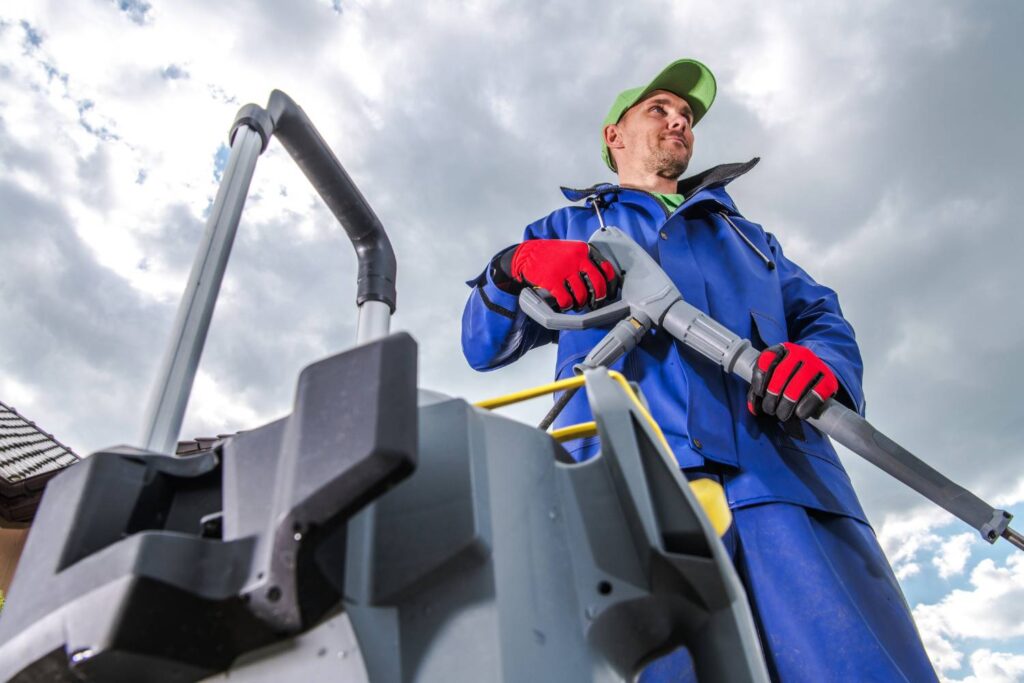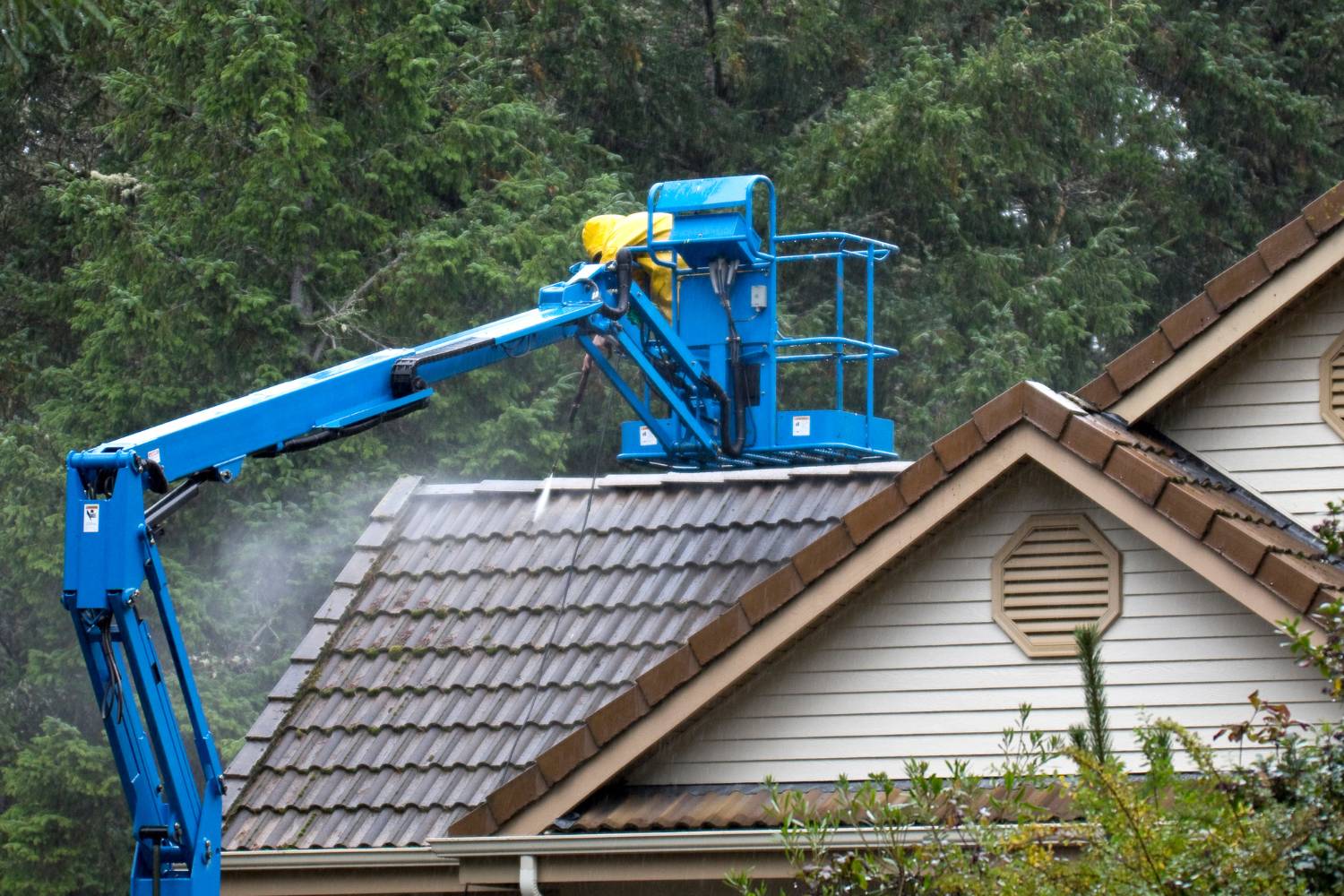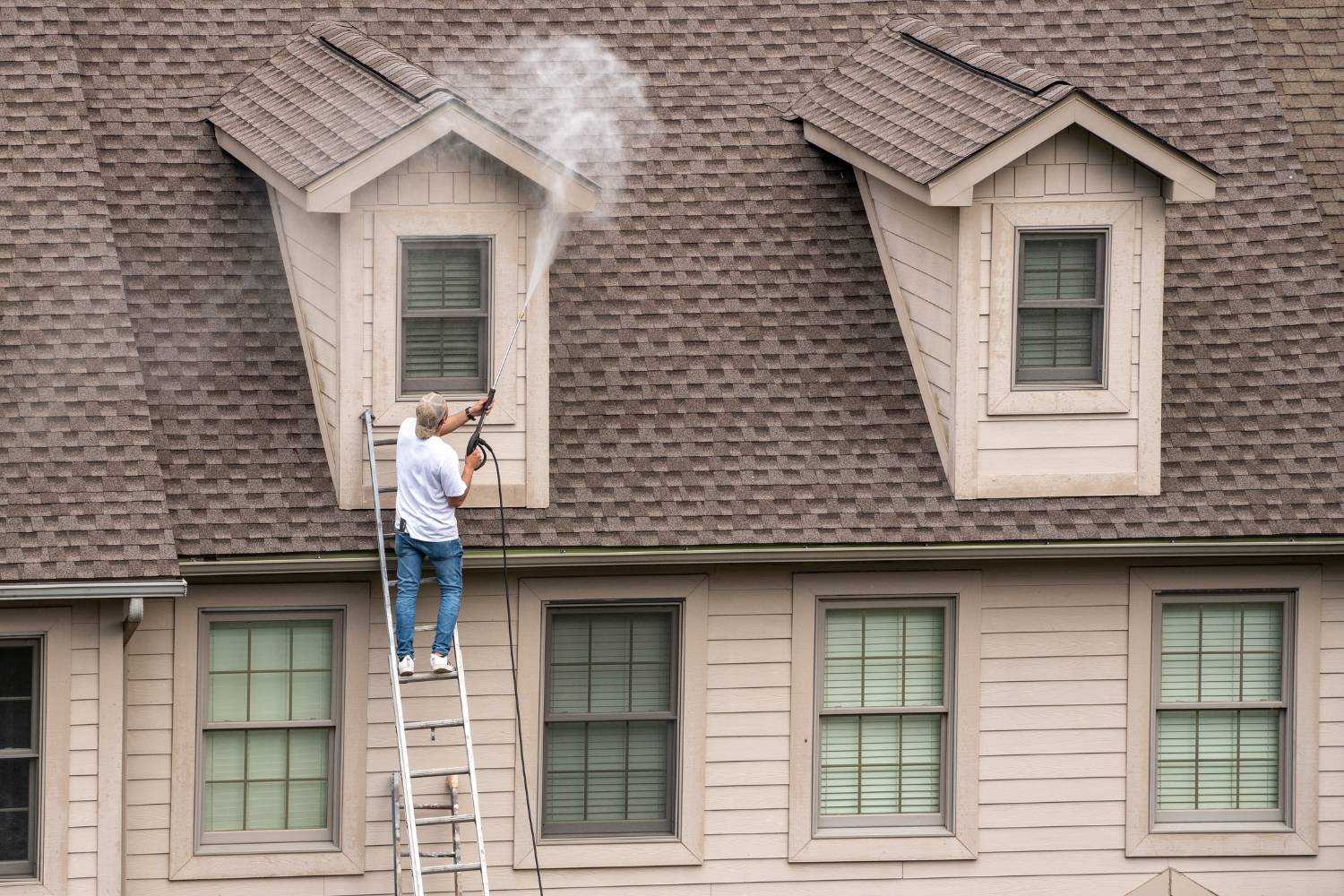Pressure washing is a common method for cleaning various surfaces, but when it comes to your roof, its safety and effectiveness are often questioned. In this article, we’ll delve into the details of pressure washing, exploring its uses, techniques, and the risks it poses to different roof types.
We'll also examine safer alternatives that can help you maintain your roof without causing damage. Whether you’re a homeowner or a professional looking to understand the best practices for roof cleaning, this guide provides the insights you need to make informed decisions.
What Is Pressure Washing?
Pressure washing, also known as power washing, is a highly effective cleaning method that uses a high-pressure water spray to remove dirt, grime, mould, and other contaminants from surfaces. This technique can be used on various surfaces, including buildings, vehicles, concrete, and decking. It is a preferred method for both residential and commercial cleaning due to its efficiency and ability to rejuvenate the appearance of surfaces.
Key Components And Setup
- Pressure Washer Types: Pressure washers come in two main types: electric and gas-powered. Electric models are generally more compact and easier to handle, making them suitable for residential use, while gas-powered models offer more power for heavy-duty commercial cleaning.
- Essential Parts: Key components of a pressure washer include the motor, hose, spray wand, and nozzles. Different nozzles provide varying pressure levels, allowing for customisation based on the cleaning task.
- Setup Process: Setting up a pressure washer involves assembling the wand, connecting the high-pressure hose, attaching a garden hose, selecting the appropriate nozzle, and ensuring proper power and water connections.
Pressure Washing Techniques
- Safety Precautions: Always wear protective gear, including eye and ear protection, and closed-toed shoes. Avoid high-voltage areas and be cautious with sensitive materials like windows and soft woods.
- Surface Preparation: Before pressure washing, remove loose debris and cover any nearby plants or objects to protect them from the high-pressure spray.
- Testing and Adjustments: Test the pressure washer on a small, inconspicuous area to gauge the appropriate pressure level. Adjust the nozzle and distance from the surface as needed to prevent damage.
- Cleaning Process: Apply detergent if necessary, using low pressure to avoid streaking. Rinse from top to bottom with clean water, maintaining a consistent distance and movement to ensure even cleaning.
Applications Of Pressure Washing
- Residential Use: Pressure washing is ideal for cleaning siding, driveways, sidewalks, decks, patios, and outdoor furniture. It helps maintain curb appeal and prolongs the life of surfaces.
- Commercial Use: Businesses use pressure washing to clean building exteriors, parking lots, and public spaces. It is also effective for vehicle fleets, including cars, trucks, and buses.
- Special Surfaces: Specific techniques are required for different materials:
- Brick: Soak and saturate the brick to prevent detergent absorption. Apply detergent from bottom to top and rinse thoroughly.
- Vinyl Siding: Use a lower pressure setting and apply detergent from bottom to top. Rinse from top to bottom to avoid streaking.
- Decks: Use a sweeping motion along the wood grain and apply a deck sealant after cleaning to protect the wood.
- Concrete: Apply detergent and allow it to soak. Use high pressure with smooth, overlapping motions to remove buildup.
Pressure Washing Vs. Power Washing
- Difference: The primary difference between pressure washing and power washing is the use of heated water in power washing. Heated water is more effective for removing tough grime, grease, and mildew.
- Best Uses: Power washing is recommended for heavily soiled surfaces like concrete and cement, which can handle the heat. Pressure washing is suitable for general cleaning tasks where heated water is not necessary.
Is Pressure Washing Safe For All Roof Types?
Pressure washers use high-pressure water sprays to clean surfaces. These machines can effectively remove grime, mould, dirt, and loose paint from objects like buildings, vehicles, and concrete. A standard pressure washer comprises a motor, which can be pneumatic, internal combustion, electric, or hydraulic. This motor powers a high-pressure water pump, a hose, and a trigger switch. Various nozzles are available, creating different spray patterns and pressure levels. These nozzles are essential for directing the water with precision and control.
Asphalt Shingles
Asphalt shingles consist of a base layer and a top layer coated with granules made of materials like quartz, schist, brick, ceramic, or stone. These granules protect the shingles and add colour. However, the high-pressure water from a pressure washer can strip these granules, degrade the shingles, and potentially puncture the underlying deck. This not only reduces the roof's lifespan but also can cause leaks, compromising the roof's integrity.
Wood Shingles
Wood shingles, while aesthetically pleasing, are quite vulnerable to damage from pressure washing. The intense water pressure can cause the wood to split or become damaged, leading to significant wear and potential water damage. This makes pressure washing an unsuitable method for cleaning wood shingle roofs.
Metal Roofs
Metal roofs are generally more durable than other roofing materials, but they are not immune to damage from pressure washing. Incorrect pressure or improper technique can dent the metal panels or strip away protective coatings. This exposes the metal to rust and corrosion, leading to long-term damage and reduced lifespan of the roof.
Slate And Tile Roofs
Slate and tile roofs are known for their strength and durability. However, they can be brittle and prone to cracking under high-pressure water. Pressure washing can easily crack or break tiles and slate, causing costly damage and reducing the effectiveness of the roof in protecting your home.
What Are The Risks Of Pressure Washing Your Roof?
Roof maintenance is crucial for preserving the longevity and structural integrity of your home. While pressure washing might seem like an efficient way to clean your roof, it poses significant risks. Here’s a detailed look into the dangers associated with pressure washing your roof and why alternative methods are recommended.
Damage To Roof Materials
Pressure washing can strip away the granular surface of roof tiles, particularly asphalt shingles. This granular layer is vital for protecting the roof from the elements, and removing it can significantly reduce the lifespan of the tiles. The high pressure can cause cracks in tiles, slates, and shingles, and can also dislodge already loose tiles, leading to leaks and further structural damage. Moreover, the force from pressure washing can weaken the underlying fabric of the roof, which is designed to protect your home’s interior from moisture.
Risk Of Water Intrusion
The intense water pressure can force water into small cracks and gaps, leading to leaks and potentially flooding your attic or ceiling. This can cause significant water damage, mould growth, and insulation problems. Additionally, features such as skylights, vents, and solar panels have seals that can be damaged by high-pressure water, resulting in leaks around these fixtures.
Hazards
Water and electricity are a dangerous combination. If water penetrates electrical systems or exterior outlets, it can lead to electrocution or severe electrical damage. Damaging the electrical systems can result in expensive repairs and pose a safety risk until fixed.
Physical Safety Risks
Wet roofs are extremely slippery, and walking on them while pressure washing increases the risk of falls and serious injuries. Manoeuvring pressure washing equipment on a roof is hazardous. The hoses and machines are cumbersome, and moving them can lead to accidents or further roof damage.
Warranty Voids
Many roof manufacturers void warranties if pressure washing is used, due to the high risk of damage. It’s essential to check your roof’s warranty terms before considering pressure washing.
Ineffectiveness And Additional Problems
Rather than removing moss and algae, pressure washing can spread these organisms to other parts of the roof, exacerbating the problem. Additionally, the debris dislodged by pressure washing can clog gutters and downspouts, leading to drainage issues and potential water damage to the home’s foundation.
Are There Alternatives To Pressure Washing?
Pressure washing is a popular method for cleaning exteriors, but it's not the only option. In fact, there are several effective alternatives that can be safer, more environmentally friendly, and just as efficient. Here’s a comprehensive look at the various alternatives to pressure washing and their benefits.
Soft Washing
Soft washing uses water-based, biodegradable solutions to clean surfaces. This method operates at significantly lower pressure than pressure washing, making it an ideal choice for cleaning delicate materials like stone without causing damage. One of the major benefits of soft washing is that it provides a longer-lasting clean by killing mould spores and preventing them from spreading. This helps surfaces stay clean four to six times longer than with traditional pressure washing. Additionally, soft washing is more water-efficient, using only one-third the amount of water compared to pressure washing.
The soft washing process begins with preparing the area by covering electrical outlets and removing small items. A cleaning solution is then applied using a low-pressure pump. This solution is allowed to dwell on the surface to open up organic spores. After sufficient dwell time, the area is rinsed, and if necessary, the solution is reapplied. It is also crucial to protect plant life during this process by using plant washes and soaking methods before, during, and after cleaning.
Hose Pipe
Using a hose pipe with a concentrated jet nozzle attachment can help remove loose dirt from surfaces. However, this method is limited in effectiveness as it cannot tackle tough, baked-on stains. The water pressure from a regular garden hose is generally insufficient for deep cleaning tasks.
Scrubbing Brush And Bucket
Manual scrubbing with a brush and soapy water is another alternative. This method is effective in removing dirt and stains with thorough scrubbing. However, it is extremely labour-intensive and time-consuming. Cleaning large areas manually is physically demanding and often impractical for most homeowners.
Cleaning Wand Attachment
A cleaning wand attachment combines a hose with an integrated scrubbing brush, allowing users to reach higher areas without the need for ladders. While this method offers some advantages in accessibility, it still suffers from the limitations of low water pressure and the physical effort required to scrub large surfaces.
Foam Cleaning
Foam cleaning involves applying thick foam containing biological agents that break down grime and stains. This method is effective for removing tough stains and requires only the pressure of a regular garden hose to rinse off the foam and dirt. Foam cleaning can be used on various surfaces, including decks, walkways, driveways, and house exteriors.
Heat Cleaning
Heat cleaning uses a heat gun to soften and remove materials like gum or tar from surfaces. While this method is highly effective on stubborn, viscous materials, it requires careful handling and is more painstaking than pressure washing. Heat cleaning should be accompanied by a scraping tool to remove the softened material and is only suitable for surfaces that can withstand high temperatures without damage.
Conclusion
While pressure washing is an effective cleaning method for many surfaces, it can pose significant risks when used on roofs. The high pressure can damage roofing materials, cause water intrusion, and create safety hazards.
Understanding these risks is crucial for homeowners and professionals alike. Safer alternatives like soft washing, manual scrubbing, or using specialised cleaning tools can help maintain the integrity and longevity of your roof without causing harm. By choosing the right method, you can ensure your roof remains clean and in good condition, protecting your home for years to come.
Frequently Asked Questions
Pressure washing involves using high-pressure water spray to remove dirt, algae, mould, and other debris from surfaces. For roofs, it can be an effective cleaning method if done correctly. However, it's important to use a lower pressure setting to avoid damaging the roofing materials, particularly shingles, tiles, or metal roofs.
Yes, if not done properly, pressure washing can cause significant damage to your roof. High-pressure water can strip away protective granules from shingles, crack tiles, and even cause water to seep under the roofing material, leading to leaks and structural damage. It's crucial to hire professionals who know how to adjust the pressure appropriately for different roof types.
Absolutely. Soft washing is a popular alternative that uses low-pressure water combined with special cleaning solutions to gently remove dirt and organic growth without damaging the roof. This method is often preferred for delicate roofing materials and provides a safer, longer-lasting clean.
No, pressure washing is not safe for all types of roofing materials. Asphalt shingles, clay tiles, and slate can be particularly vulnerable to high-pressure water. Metal roofs may handle pressure washing better, but it's still essential to use the correct pressure setting and technique to prevent damage.
To ensure your roof is cleaned safely, hire a professional roof cleaning service with experience in both pressure washing and soft washing techniques. They should assess your roof type, condition, and the level of dirt or growth before deciding on the best cleaning method. Additionally, check that they use appropriate pressure settings, cleaning solutions, and equipment designed for roof cleaning.


